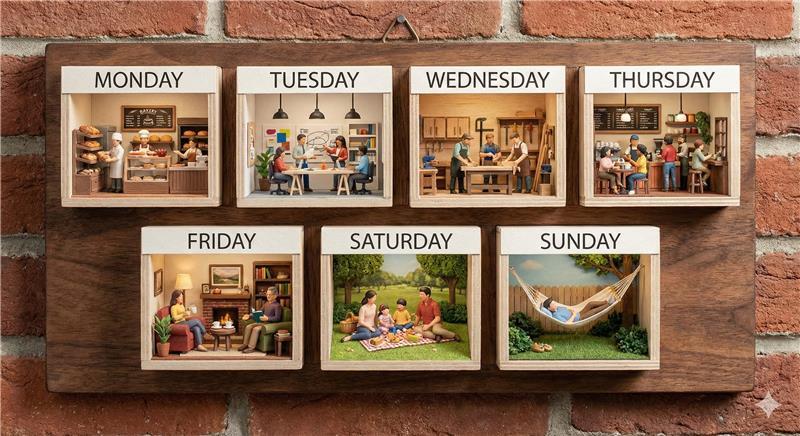How to Know If a Four-Day Workweek Is Right for Your Business
The four-day workweek has become one of the most talked-about workplace shifts of the last decade. Large corporations are experimenting with it....

Most small businesses start planning for the new year in January. The only problem? You’re already behind. STARTING in January means that you probably aren’t executing on a lot of these ideas until close to March – by then the first quarter is basically over. So how do you switch from being reactive to being proactive with your business?
Well, you start a little earlier. Here’s the good news: With a little bit of guidance and planning, it’s actually not that much work to make sure that you’re starting 2024 off on the right foot. So when do we start? December? November? Actually, we’re shooting for an October start to our year end planning.
October is all about getting the numbers together from the current year so that you can make educated decisions on where your business goes in the next year. The first thing you’ll do with your CPA (or if you don’t have a CPA, you’ll have to do this yourself) is to create a status report on where the business sits year to date. That means we want YTD profit and tax projections through the end of the year.
With that knowledge, you’ll have to make some decisions. In fact – and this surprises some people – some of those decisions have to be made by October already. 401k plans that need to be put in place? Well most of those have deadlines in October. You’ll look at your profits, think about potential purchases.
Here’s something you may not know about tax deductible equipment purchases: those have to be in use by the end of the year. It does no good to buy the equipment you need on December 31st – unless you’re planning on deducting the following year.
So let’s skip ahead a little. You have your report, now it’s time for your goals. Do you have growth goals? Are you looking to be steady as it goes, or maybe are you getting ready to weather the storm? Figure out where you want to be and start doing litmus tests to see if it’s reasonable.
Say you want your business to grow ten percent. Ask yourself: Do I have a sales plan in place? Do I have my lead sources dialed in? Do I have the right staff? Do I have a sales plan for 2024? Is this growth plan realistic? Now, you might not have answers to all these questions, but they will get you to the three bedrocks of creating a business plan for the new year — a sales plan, a financing plan, and a staffing plan. Let’s go through them one by one to see what we need.
Start with the goal that you stated earlier. Now it’s all about creating supporting plans to get there. You’ll have to ask yourself some tough questions. A sales plan asks: do I have the opportunity to bring the money I need through the door? To understand that, ask yourself: Is there strong enough demand right now? Do we have enough staff to sell and close the business that may come in? Do I have a robust enough marketing plan? Is my spend enough?
While these questions may seem intense, they’re integral to creating your sales plan. Most small businesses want growth first THEN they try and hire. We’ll talk more about this in future blogs, but for now understand that your sales plan will need to integrate with your other two plans if you have hope of meeting your goals.
Your hiring plans need to do two things: cover any new growth you need and ALSO the attrition of employees. What do we mean by attrition? Well, employees leave businesses. It can happen for any number of reasons, but if you have an attrition of 1-3 employees, taking that into consideration is an absolute must.
Not only that, we’ll have to think about the time it takes for them to become an actual money making part of your team. What is the ramp up time? Do you have good onboarding procedures so that these employees will be trained and empowered as soon as possible? Most small businesses want growth first THEN they try and hire. If that’s the case, you’ll always be lagging behind. Instead, plan for growth and understand when you’ll need to hire and train.
Of course a CPA blog would say that the financial plan is the most important – but it’s true. Money is the lifeblood of your business. Budgeting and tracking are the ways in which you make sure your business is healthy. Consider ongoing expenses, are they trending up? Your staff will need raises, your internal costs may be higher than you expect.
That means going line by line through your financials to see what’s ACTUALLY happening. Sure, internal costs might be up 10% overall, but there could be certain areas that are only up 5% while others are up 25%. We’ll get more into this in the future, but suffice to say you’ll want to get your CPA involved and create a robust plan.
Why? Because these three plans work in concert with each other. The good news? When you plan like this, you set yourself up for meaningful success. That means growth – and like everything else in the world, you’ll see that growth in bloom by the spring.
Read this next: Small Business Growth Planning for the End of the Year

The four-day workweek has become one of the most talked-about workplace shifts of the last decade. Large corporations are experimenting with it....

We've all seen the headlines. Another major company announces that everyone needs to be back at their desk. No exceptions. And if you're running a...

If you work with a payroll provider for your small business, payroll typically runs on a set schedule with very little day-to-day involvement from...